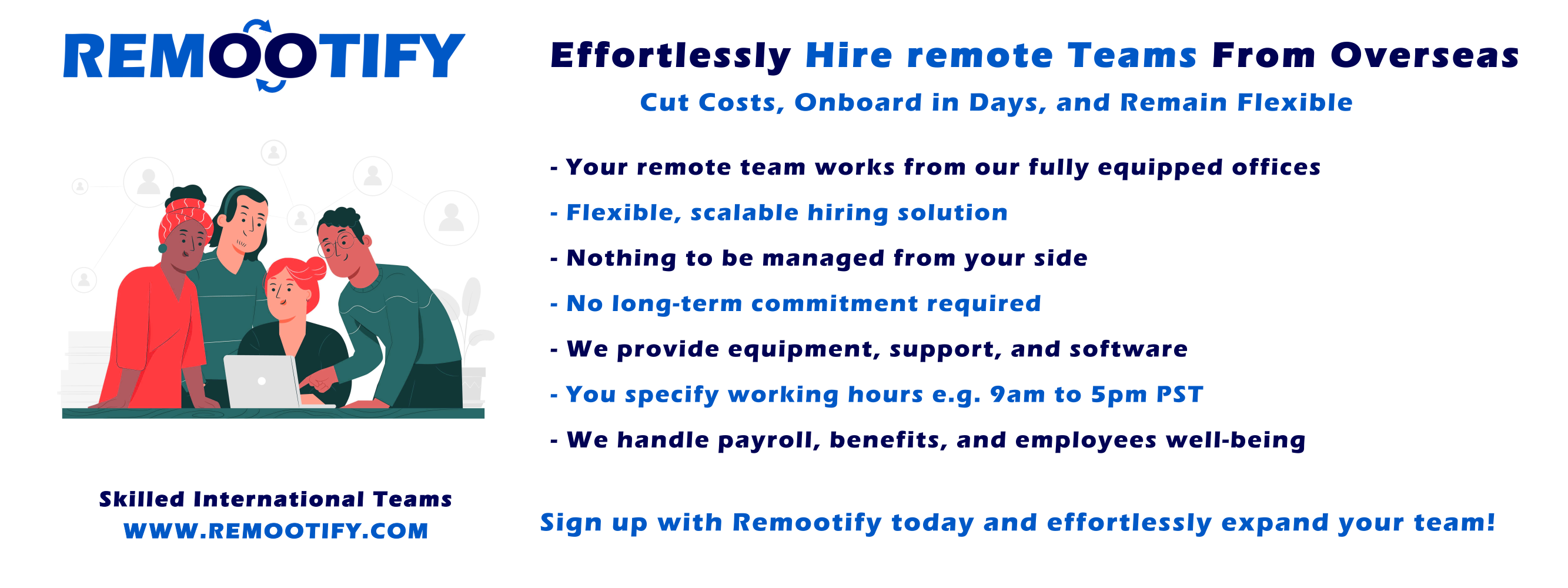Start hiring YOUR REMOTE TEAM, Today!
Enter your information below to start a discussion with one of our team members!

Are you curious about in-kind benefits and how they can enhance your employees’ job satisfaction? In-kind benefits are non-cash perks that companies offer to motivate and retain their staff.
This blog post will provide a comprehensive guide, delving into the various types of in-kind benefits including healthcare plans, childcare support, and more. Keep reading to discover how these unique bonuses can revolutionize your workplace culture!
Key Takeaways
- In-kind benefits are non-cash perks that companies offer to motivate and retain their employees.
- Examples of in – kind benefits include gym memberships, onsite fitness classes, subsidized meals, educational opportunities, flexible scheduling options, transportation benefits, and childcare assistance programs.
- In-kind benefits can enhance employee satisfaction, improve engagement and retention rates, boost morale, promote work-life balance, and attract top talent.
- Companies that prioritize in-kind benefits show their commitment to supporting employee well-being and create a positive work environment.
What are In-kind Benefits?
In-kind benefits are noncash perks provided by employers to employees, which can include goods and services such as accommodation, meal plans, car allowances, medical benefits, relocation expenses, education assistance, retirement benefits, and family and childcare benefits.
Definition of in-kind benefits
In-kind benefits are perks that companies give workers. These are not cash but still have value. They help make work more enjoyable and life better balanced. They come in many forms.
This could be a good gym membership, fun work get-togethers, free lunch or snacks, or even ways to learn new things at work. Working from home options and flexible hours are also common in-kind benefits.
Even though these benefits aren’t money given by the boss, they can save workers money and make them feel happier at their jobs.
Examples of in-kind benefits
In-kind benefits are non-cash perks offered by companies to their employees. Here are some examples of in-kind benefits:
- Gym memberships and wellness programs
- Onsite fitness classes and exercise facilities
- Employee assistance programs for counseling and mental wellness support
- Subsidized meals or snacks at work
- Company – sponsored events or outings
- Educational or professional development opportunities, such as tuition reimbursement or training programs
- Paid parental leave to promote work-life balance
- Flexible scheduling options or telecommuting opportunities
- Transportation benefits, like company cars or car allowances
- Childcare assistance programs
Types of In-kind Benefits
The types of in-kind benefits include accommodation, meal plans, car allowances, medical benefits, relocation expenses, education assistance, retirement benefits, and family and childcare benefits.
Accommodation
In-kind benefits can include accommodation options provided by companies to their employees. This could involve offering housing or rental assistance, especially for those who have to relocate for work.
Providing accommodation as an in-kind benefit helps employees maintain a good work-life balance and reduces the stress of finding suitable housing on their own. It is one way that employers can support their staff by ensuring they have a safe and comfortable place to live while working for the company.
Meal plans
Companies often provide meal plans as part of their in-kind benefits to employees. Meal plans can vary from offering complimentary snacks and beverages in the office to providing fully subsidized meals for employees during working hours.
This benefit not only saves employees money but also promotes a healthy work-life balance by eliminating the need to prepare or purchase meals outside of work. By offering meal plans, companies can enhance employee satisfaction, improve productivity, and foster a sense of community within the workplace.
Examples of meal plan benefits include on-site cafeterias or food trucks, catered lunches during meetings or events, and vouchers for local restaurants or delivery services.
Car allowances
Car allowances are a type of in-kind benefit that some companies offer to employees. Instead of providing a company car, employers give their workers a set amount of money each month to cover the costs associated with using their personal vehicle for work-related purposes.
This allowance can help employees pay for gas, insurance, maintenance, and other expenses related to using their car for business needs. Car allowances can be attractive to employees who prefer using their own vehicles and gives them more flexibility when it comes to choosing the type of car they want.
It also helps companies save on the costs of purchasing and maintaining a fleet of company cars.
Medical benefits
Medical benefits are an important type of in-kind benefit that companies offer to their employees. These benefits can include health insurance coverage, access to medical professionals, and assistance with healthcare expenses.
Medical benefits help employees take care of their physical well-being and ensure they have access to necessary medical treatments. They also provide peace of mind by reducing the financial burden associated with healthcare costs.
Companies that offer comprehensive medical benefits demonstrate their commitment to employee wellness and contribute to a positive work environment. By providing these benefits, companies not only attract top talent but also prioritize the health and well-being of their workforce.
Relocation expenses
Relocation expenses are a type of in-kind benefit that some companies offer to help employees cover the costs of moving to a new location for work. These expenses can include things like packing and shipping belongings, transportation costs, temporary housing or hotel stays, and even assistance with finding a new home.
Relocation benefits are particularly common for employees who are being transferred to another office or starting a new job in a different city or country. By providing support with relocation expenses, companies aim to make the transition smoother for their employees and ensure they have everything they need to settle into their new environment quickly and comfortably.
Education assistance
Education assistance is a type of in-kind benefit that some companies offer to their employees. This perk helps employees further their education by providing financial support or resources for tuition, books, or training programs.
It can also include opportunities for professional development and skill enhancement. Education assistance is beneficial because it allows employees to expand their knowledge and skills, which can lead to career advancement and increased job satisfaction.
Some examples of education assistance include reimbursement programs where the company pays a portion or all of the employee’s educational expenses, scholarships or grants specifically for employees, on-the-job training programs, mentorship opportunities, and access to online courses or workshops.
Retirement benefits
Retirement benefits are a type of in-kind benefit that companies can offer to their employees. These benefits help workers save for their future and provide financial security after they retire.
Some common retirement benefits include employer-sponsored pension plans, 401(k) plans, and individual retirement accounts (IRAs). These programs allow employees to contribute a portion of their salary towards retirement savings, often with matching contributions from the employer.
By offering retirement benefits, companies show their commitment to supporting employees throughout their careers and helping them achieve long-term financial goals.
Family and childcare benefits
Family and childcare benefits are an important aspect of in-kind benefits that companies can offer to their employees. These benefits aim to support employees who have families or dependents, helping them achieve a better work-life balance.
Examples of family and childcare benefits include subsidized daycare services, flexible working hours, parental leave options, and assistance with adoption expenses. By providing these benefits, companies show their commitment to supporting the well-being of their employees and recognizing the importance of family responsibilities.
This can lead to increased employee satisfaction, loyalty, and productivity.
Benefits of In-kind Benefits
In-kind benefits offer several advantages, including improved employee engagement, a strategic recruitment strategy, enhanced employee retention, boosted morale, improved mental well-being, and tax benefits.
Improved employee engagement
In-kind benefits play a crucial role in improving employee engagement. When companies provide employees with non-cash perks like flexible working arrangements, wellness programs, and professional development opportunities, it shows that they value their well-being and growth.
Employees who feel supported and appreciated are more likely to be engaged in their work, leading to higher productivity and job satisfaction. By offering these types of benefits, companies can create a positive work environment where employees feel motivated and connected to the organization’s goals.
This ultimately contributes to improved employee retention rates and attracts top talent looking for comprehensive support beyond just monetary compensation.
Recruitment strategy
In-kind benefits can play a crucial role in a company’s recruitment strategy. By offering attractive non-cash perks, companies can stand out from the competition and attract top talent.
These benefits show potential employees that the company values their well-being and work-life balance, which can be a deciding factor for job seekers. In-kind benefits like flexible working arrangements, childcare assistance, or educational opportunities can entice candidates to choose one company over another.
Additionally, these benefits can also help with employee retention by fostering loyalty and satisfaction among current employees. Companies that prioritize in-kind benefits have an advantage when it comes to attracting and retaining top performers.
Employee retention
Employee retention is a crucial aspect of any company’s success. In-kind benefits can play a significant role in keeping employees happy and satisfied in their jobs. By offering non-cash perks such as flexible work schedules, wellness programs, and professional development opportunities, companies can create an environment where employees feel valued and supported.
This, in turn, increases job satisfaction and reduces turnover rates. In-kind benefits show employees that their well-being is important to the company, fostering loyalty and long-term commitment to the organization.
Boosted morale
In-kind benefits can have a significant impact on employee morale. When companies provide perks and resources outside of traditional compensation, it shows that they value their employees’ well-being and happiness.
This, in turn, boosts morale and creates a positive work environment. Employees feel appreciated and supported, leading to increased job satisfaction and productivity. In-kind benefits like flexible work arrangements, wellness programs, or company-sponsored events contribute to the overall sense of belonging and motivation within the workplace.
By prioritizing employee well-being through these non-cash perks, companies can create a more engaged and motivated workforce.
Improved mental well-being
In-kind benefits can play a crucial role in improving the mental well-being of employees. By offering perks like access to counseling services, wellness programs, and flexible working arrangements, companies can create a supportive environment that promotes overall emotional health.
These benefits demonstrate that employers value their employees’ well-being beyond just their work output. Research shows that employees who have access to such benefits experience lower stress levels, higher job satisfaction, and greater work-life balance.
This not only helps individuals thrive personally but also contributes to a more positive and productive work environment as a whole.
Tax benefits
In addition to the many advantages of in-kind benefits, there are also tax benefits for both employers and employees. When it comes to taxes, in-kind benefits are generally not considered taxable income for employees.
This means that employees do not have to pay taxes on the value of the benefits they receive. Additionally, employers can often deduct the cost of providing in-kind benefits as a business expense, which can help reduce their overall tax liability.
It’s important for employers and employees alike to understand the specific tax implications of different types of in-kind benefits and consult with a tax professional if necessary.
Law and Tax Policies for In-kind Benefits
Understanding legal and tax implications is crucial in ensuring compliance with regulations regarding in-kind benefits.
Understanding legal and tax implications
In-kind benefits can have legal and tax implications for both employers and employees. Companies must understand the laws and regulations surrounding these benefits to ensure compliance.
While in-kind benefits are generally not considered taxable income for employees, there may still be tax obligations for employers. It is important for companies to accurately report and document their in-kind benefit offerings to avoid any potential issues with taxation.
Employers should consult with legal and tax professionals to fully understand the legal requirements and implications of providing in-kind benefits.
Compliance with regulations
Companies offering in-kind benefits must ensure compliance with relevant regulations to avoid legal and tax issues. While in-kind benefits are generally not considered taxable income for employees, employers may have certain reporting requirements or obligations.
It is crucial for companies to understand the legal and tax implications of providing these benefits and stay up-to-date with any changes or updates to regulations. By complying with regulations, companies can maintain a positive relationship with their employees while avoiding potential penalties or disputes related to in-kind benefit offerings.
Frequently Asked Questions
What are some common queries regarding in-kind benefits and how do you ensure accurate valuation of in-kind contributions?
Common queries regarding in-kind benefits
- What are in – kind benefits and how do they differ from monetary compensation?
- Do all companies offer in – kind benefits to their employees?
- Can employees choose which in – kind benefits they receive?
- How are in – kind benefits valued for tax purposes?
- Are in – kind benefits considered taxable income for employees?
- What legal and tax implications should companies be aware of when offering in – kind benefits?
- Can employees negotiate or request specific in – kind benefits?
- Are there any limitations or restrictions on certain types of in – kind benefits?
Clarification on tax deductibility and reporting
When it comes to tax deductibility and reporting for in-kind benefits, there are a few important factors to consider:
- Employers may be able to deduct the cost of providing in – kind benefits as a business expense on their taxes.
- However, some in – kind benefits may not be fully tax deductible or may have limitations on their deductibility.
- It is important for employers to consult with a tax professional or accountant to understand the specific rules and regulations regarding deductibility.
- Employers may also need to report the value of certain in-kind benefits provided to employees on tax forms, such as Form W-2 or 1099-MISC.
- The value of these benefits should be accurately calculated and reported based on their fair market value or any applicable guidelines provided by the IRS.
- Employees should also be aware that while they do not have to pay income tax on the value of in – kind benefits, certain fringe benefits may still be subject to Social Security and Medicare taxes.
Tips for valuing in-kind contributions accurately
Valuing in-kind contributions accurately is important for both employers and employees. Here are some tips to help ensure accurate valuation:
- Determine the fair market value: Assess the market rate for similar goods or services to determine the fair value of the in-kind contribution.
- Consult professionals: Seek guidance from tax experts or accountants who specialize in valuing noncash benefits to ensure compliance with tax regulations.
- Document the valuation process: Keep detailed records of how the valuation was determined, including any supporting documentation or research used.
- Consider employee preferences: Take into account employee satisfaction and perception when assigning a value to in-kind benefits, as this can impact their overall satisfaction and engagement.
- Regularly review valuations: Stay up-to-date with market changes that may affect the value of in-kind contributions, and adjust valuations accordingly.
- Communicate clearly: Clearly communicate the value of in-kind benefits to employees so they understand and appreciate their true worth.
- Review legal requirements: Understand any legal requirements or reporting obligations related to valuing in-kind contributions, and ensure compliance with relevant laws and regulations.
Conclusion
In conclusion, understanding the various types of in-kind benefits can help companies enhance job satisfaction and work-life balance for their employees. From accommodation and meal plans to car allowances and healthcare benefits, these non-cash perks can have a significant impact on employee morale and overall job satisfaction.
By offering comprehensive in-kind benefits, companies can attract and retain top talent while creating a positive work environment that promotes employee well-being.
FAQs
1. What are in-kind benefits for workers?
In-kind benefits for workers include nonmonetary perks like healthcare benefits, lunch vouchers, and sabbaticals that add cash value to compensation.
2. Can you tell me about the different types of employee benefits?
Employee perks vary but can include work-life balance steps such as flexible hours, health coverage, and other forms of nonmonetary compensation known as ‘benefits in kind’.
3. What does understanding in-kind benefits mean?
Understanding in-kind benefits refers to getting familiar with noncash awards given by employers such as health amenities or lunch coupons which increase an employees’ total pay-off.
4. Could you provide common examples of these inkind contributions?
Common examples of these contributions could be a federally-assisted project helping an employee’s cause or providing all staff members with certain healthcare services.
5. How would exploring various types of employee perks help one’s job position?
Exploring the various types helps create awareness about worker rights regarding assorted categories of noncash gains; it empowers workers to demand what they’re due besides their regular salary.





